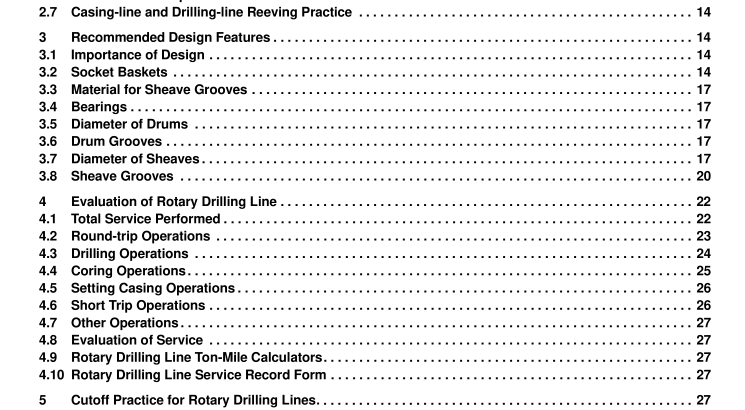API RP 9B:2015 pdf free download.Application, Care, and Use of Wire Rope for Oil Field Service
2.3.3.5 When working near the minimum design factor, consideration should be given to the efficiencies of wire rope bent around sheaves, fittings, or drums. Figure 3 shows how rope can be affected by bending. 2.3.4 Winding on Drums Rope should be kept tightly and evenly wound on the drums. Sufficient tension must be applied to the dead wraps on the drill line after making a cut or during installation to prevent it being forced from the lagging and crushed or damaged.
2.3.5 Application of Loads Sudden, severe stresses are injurious to wire rope and such applications should be reduced to a minimum.
2.3.6 Operating Speed Experience has indicated that wear increases with speed; economy results from moderately increasing the load and diminishing the speed.
2.3.7 Rope Speed High speeds when running blocks under light load may cause damage to the wire rope. “Whipping” of the wire rope may cause contact with sheave guards or other structural members.
2.3.8 Lubrication of Wire Rope Wire ropes are well lubricated when manufactured; however, the lubrication will not last throughout the entire service life of the rope. Periodically, therefore, the rope will need to be field lubricated. When necessary, lubricate the rope with a compatible lubricant which will penetrate and adhere to the rope, and which is free from acid or alkali.
2.3.9 Clamps and Rotary Line Dead-End
Tie Down The clamps used to fasten lines for dead-ending shall not kink, flatten, or crush the rope. The rotary line dead-end tie down is equal in importance to any other part of the system. The deadline anchorage system shall be equipped with a drum and clamping device strong enough to withstand the loading, and designed to prevent damage to the wire line that would affect service over the sheaves in the system. Consideration should be given to adding a second clamp at the deadline anchor when a plastic filled drill line is used to further reduce the likelihood of slippage.
2.3.10 Wire Breakage from Martensite in Drilling Lines Care should be taken to maintain proper winding of rotary drilling lines on the drawworks drum in order to avoid excessive friction which may result in the formation of martensite. Martensite may be formed by excessive friction at kick over points on the drum, in worn grooves of sheaves, slippage in sheaves, or friction resulting from rubbing against a derrick member. A line guide should be employed between the drum and the fast line sheave to reduce vibration and keep the drilling line from rubbing against the derrick. On rigs with motion compensations, the high line speeds and sudden direction reversals can cause rope slippage in sheave grooves which can result in martensite formation.
NOTE 1 Martensite is a hard, nonductile micro constituent that is formed when steel is heated above its critical temperature and cooled rapidly. In the case of steel of the composition conventionally used for rope wire, martensite can be formed if the wire surface is heated to a temperature near or somewhat excess of 1400 °F (760 °C), and then cooled at a comparatively rapid rate. The presence of a martensite film at the surface of the outer wires of a rope that has been in service is evidence that sufficient frictional heat has been generated on the crown of the rope wires to momentarily raise the temperature of the wire surface to a point above the critical temperature range of the steel. The heated surface is then rapidly cooled by the adjacent cold metal within the wire and the rope structure and effective quenching results.
NOTE 2 Detail A of Figure 4 shows a rope, which has developed fatigue fractures at the crown in the outer wires, and Detail B of Figure 4 shows a photomicrograph (100× magnification) of a specimen cut from the crown of one of these outer wires. This photomicrograph clearly shows the depth of the martensitic layer and the cracks produced by the inability of the martensite to withstand the normal flexing of the rope. The initial cracks in the martensitic layer cause the failures appearing on the crown of the outer wires of this rope. The result is a disappointing service life for the rope. Most outer wire failures may be attributed to the presence of martensite, if this hard constituent is known to have been formed.API RP 9B pdf download.API RP 9B:2015 pdf free download
